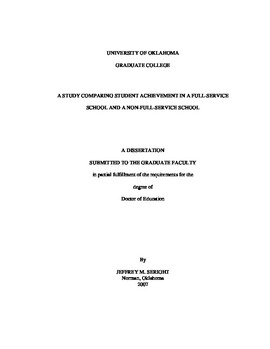| dc.contributor.advisor | Noley, Grayson, | en_US |
| dc.contributor.author | Seright, Jeffrey M. | en_US |
| dc.date.accessioned | 2013-08-16T12:20:51Z | |
| dc.date.available | 2013-08-16T12:20:51Z | |
| dc.date.issued | 2007 | en_US |
| dc.identifier.uri | https://hdl.handle.net/11244/1236 | |
| dc.description.abstract | Student achievement indicators in the two schools were compared. The schools were similar in enrollment, community type, percent low-income students, and percent minority students. Data gathered from the schools was retrieved from each school's State Department of Education website report card database. | en_US |
| dc.description.abstract | A t-test was used to compare data between the schools. A difference was significant when p< 0.05. In all the areas tested, the null hypothesis was rejected. The null hypothesis was rejected due to a significant difference in academic achievement between the two schools understudy. The differences in student achievement indicators were explained primarily as differences in the characteristics of student groups in the two schools. An implication of the study is that implementation of the full-service school model does not necessarily contribute to improved student achievement. | en_US |
| dc.description.abstract | The purpose of this study was to examine differences in student achievement indicators in a full-service school and at a demographically similar, non-full-service school. A full-service school integrates the delivery of quality educational services with needed health and social services. Evaluation of student learning outcomes in full-service schools is important to policy level support for coordination of services for children. | en_US |
| dc.description.abstract | The student achievement indicators compared were proficiency levels attained on the individual state's proficiency exams in the areas of English (Reading) over a four-year period for tenth grade students, and a three-year period for all ninth grade students in the area of Algebra I. Additionally, dropout rates and graduation rates were compared over a four-year period. These were considered achievement related factors. | en_US |
| dc.format.extent | xiii, 132 leaves : | en_US |
| dc.subject | Academic achievement Case studies. | en_US |
| dc.subject | School children Services for Case studies. | en_US |
| dc.subject | Social service Oklahoma. | en_US |
| dc.subject | School facilities Extended use Oklahoma. | en_US |
| dc.subject | Community and school Florida. | en_US |
| dc.subject | School facilities Extended use Case studies. | en_US |
| dc.subject | School facilities Extended use Florida. | en_US |
| dc.subject | Social service Florida. | en_US |
| dc.subject | Community and school Case studies. | en_US |
| dc.subject | Family services Case studies. | en_US |
| dc.subject | Academic achievement Florida. | en_US |
| dc.subject | Family services Oklahoma. | en_US |
| dc.subject | School children Services for Florida. | en_US |
| dc.subject | Social service Case studies. | en_US |
| dc.subject | Education, Curriculum and Instruction. | en_US |
| dc.subject | Community and school Oklahoma. | en_US |
| dc.subject | School children Services for Oklahoma. | en_US |
| dc.subject | Family services Florida. | en_US |
| dc.subject | Academic achievement Oklahoma. | en_US |
| dc.title | A study comparing student achievement in a full-service school and a non-full-service school. | en_US |
| dc.type | Thesis | en_US |
| dc.thesis.degree | Ed.D. | en_US |
| dc.thesis.degreeDiscipline | Department of Educational Leadership and Policy Studies | en_US |
| dc.note | Source: Dissertation Abstracts International, Volume: 68-06, Section: A, page: 2307. | en_US |
| dc.note | Adviser: Grayson Noley. | en_US |
| ou.identifier | (UMI)AAI3271220 | en_US |
| ou.group | Jeannine Rainbolt College of Education::Department of Educational Leadership and Policy Studies | |
